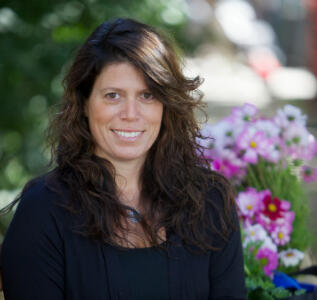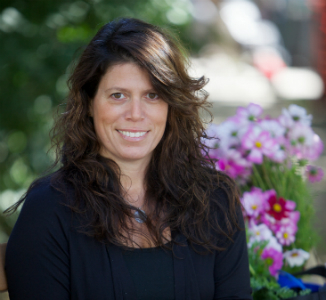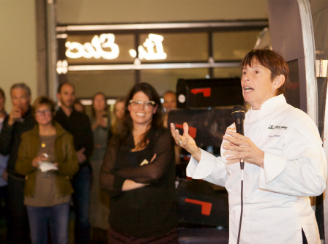
The Road to School Food Change
An Interview with Executive Director Mara Fleishman
April 02, 2015
Mara Fleishman is a force to be reckoned with in the world of school food reform. Her passion for ensuring that every child has access to healthy, nourishing food at school is contagious—after all, Mara’s drive is what brought Chef Ann Cooper to Boulder, Colorado, where Chef Ann would transform the food program at Boulder Valley School District and establish the Chef Ann Foundation. Five years later, we sit down with Mara to tell her story of how she came to be the school food champion she is today.
Where did your passion for good, healthy food begin?
The reason I got into food is because in 1992 I was diagnosed with a unique autoimmune eye disease called Uveitis, which I was told could ultimately lead to blindness. There were no cures and the only treatment option suggested by doctors involved steroid injections in my eyes, which I did not want. But my eyesight kept deteriorating, so I started researching alternative remedies and found that a big contingent of naturopaths supported nutritional changes to the diet, eating healthier, as a treatment. That was really when I started getting invested in it.
What was your relationship to food like before you found out about your eye condition?
Honestly, I didn’t think about it. I didn’t think of my body as something I had to take care of. I thought of it as a workhorse that would take me from A-Z. In college I ate a lot of unhealthy foods, lots of carbs, dairy, sugar, and I didn’t get enough rest. I was diagnosed when I was 22, and that’s when I started to change.
Did changing your diet make a difference?
Yes! A big part of it was limiting my sugar and general caretaking of my body—getting enough rest, getting enough fruits and vegetables. My condition was active for many years but it was contained by the diet and some conventional treatment. And now I’m in remission.
So how did you turn your healthy lifestyle into a career?
As I started to do this investigation into a healthier lifestyle, I saw this marketing support job open up in a natural products company in Portland, OR. I had become so passionate about natural alternatives to health that I interviewed and got the job.
I worked there for three years before moving back to Boston when I was pregnant with my first child. We wanted to be closer to our families and I had made the decision to take time away from work. But it just so happened that Whole Foods needed a Director of Marketing for their North Atlantic Region. I was eight months pregnant when I interviewed for the job!
What was it like working for Whole Foods Market?
Working at Whole Foods is like getting a masters degree in food sustainability—it’s incredible the kind of information they provide to their team members and how they go above and beyond—they don’t just wait until customers ask for something, they try and blaze the path for food sustainability issues.
Can you give an example?
I can remember in 2003, no one was asking for local product; it wasn’t a thing yet. I was sitting in a meeting and one of our buyers came in and said he wanted to switch out the milk we were buying for the whole region to local milk, because it would reduce our environmental impact, support local farmers and provide customers with a fresher product. We did it, and now buying local is mainstream.
When did you make the move to Boulder, Colorado?
I moved to Boulder in 2006, leaving the marketing position. But Whole Foods offered me the opportunity to work on special projects, which I did until I took the role of Global Director of Partnerships in 2008.
What did that role entail?
It was basically managing all the partnerships that Whole Foods had nationally, partners like Martha Stewart, Top Chef, and national non-profits like what would become the Chef Ann Foundation (CAF). It was super exciting because I was really able to offer support to initiatives that were doing pretty amazing things.
How did you connect with Chef Ann Cooper?
During this period in my life, I was using my personal volunteer time to help change the school food and nutrition education offered at the Boulder Valley School District, because of my kids. I was working with a small group of parents to look at food programing alternatives, and we were meeting with the district, but the group was not getting anywhere. One of the group members knew of Ann’s work to change school food in Berkeley, California, so we got in touch. Ann came out to Boulder and as soon as she did we all knew that she was the answer. She evaluated the district and gave them a plan to improve their meal program. They agreed and then extended her an offer to come do the work herself as their food service director. She said yes.


How did you connect with Chef Ann Cooper?
During this period in my life, I was using my personal volunteer time to help change the school food and nutrition education offered at the Boulder Valley School District, because of my kids. I was working with a small group of parents to look at food programing alternatives, and we were meeting with the district, but the group was not getting anywhere. One of the group members knew of Ann’s work to change school food in Berkeley, California, so we got in touch. Ann came out to Boulder and as soon as she did we all knew that she was the answer. She evaluated the district and gave them a plan to improve their meal program. They agreed and then extended her an offer to come do the work herself as their food service director. She said yes.
So when did the Chef Ann Foundation come along?
Ann asked to meet one day—she had this idea of how she could help more than one school at a time by creating a free online resource center that would offer school food support to any district that was looking to make change. She called it The Lunch Box. She wanted to know if Whole Foods could support her idea. I took it to all the regions and they were on board, so we launched a national fundraiser at registers throughout the country and raised $750,000 in 6 weeks!
That’s how we knew people really wanted to change school food. It was the start of Whole Foods’ ongoing partnership with CAF and was the basis for creating the Whole Kids Foundation, so now Whole Foods has its own organization to support nutrition and healthy living for children. It was definitely one of the most exciting times in my career because it made me realize how passionate I was about school food. Ann asked me to become a CAF board member in 2010 and I said ‘yes.’
Tell us about your transition from Whole Foods to CAF?
It was 2013. By this time I had three kids and I had worked really hard through the birth of them all—I needed to take a step back and spend time with my family, so I left Whole Foods. Ann and I had become friends at this point and she started hinting at me to come run the foundation. I had never seen myself running a non-profit—I was a businessperson—but I was so passionate about what Ann did, and by this point Boulder had such a GREAT school food program that I wanted to help bring Ann’s model to districts nationally. So I said I would give it a try, but only if I could work 20 hours a week. I had committed to spending more time with my family and Ann understood that.

How has CAF evolved since you began as the Executive Director?
CAF started with The Lunch Box, but I kept seeing additional opportunities to support schools, and there’s so much work left to do, but really we’re in such a different place than when I started—over 4,000 salad bars in schools, and fresh fruits and vegetables are no longer totally rare in the cafeteria. We have this incredible niche at CAF; there’s a lot of organizations out there that are helping to improve the health and lives of children, but what we offer is operational support to food service teams to help them create healthier school food, and that for me is a perfect fit. It’s not obtuse, it’s specific. It’s something that affects change and that’s probably the most exciting thing.

How has CAF evolved since you began as the Executive Director?
CAF started with The Lunch Box, but I kept seeing additional opportunities to support schools, and there’s so much work left to do, but really we’re in such a different place than when I started—over 4,000 salad bars in schools, and fresh fruits and vegetables are no longer totally rare in the cafeteria. We have this incredible niche at CAF; there’s a lot of organizations out there that are helping to improve the health and lives of children, but what we offer is operational support to food service teams to help them create healthier school food, and that for me is a perfect fit. It’s not obtuse, it’s specific. It’s something that affects change and that’s probably the most exciting thing.
What do you see as the ideal picture of school food?
The ideal picture of school food would include a cook-from-scratch program—Ann has shown me why this is such a necessity. With the limited funds we have to spend per meal, it’s the only healthy way to go.
Also, bringing back the value to mealtime that we once had is an important component. When kids are eating their lunch in a makeshift cafeteria in 20-minute time slots, and their going through lines and food is being scooped out quickly, it devalues the nature of the meal. I think we owe it to our culture to build in value to our meals—to change that scenario and to make the cafeteria a place of learning just like all of the other rooms in a school.
To this day, the most important thing a child can learn in school is how to take care of their bodies, because they cannot be successful if their bodies break down. Nourishing school food is the first line of defense for helping kids achieve in their life.
Interested in reading more helpful articles from us? Sign-up for our newsletter in the footer below.







